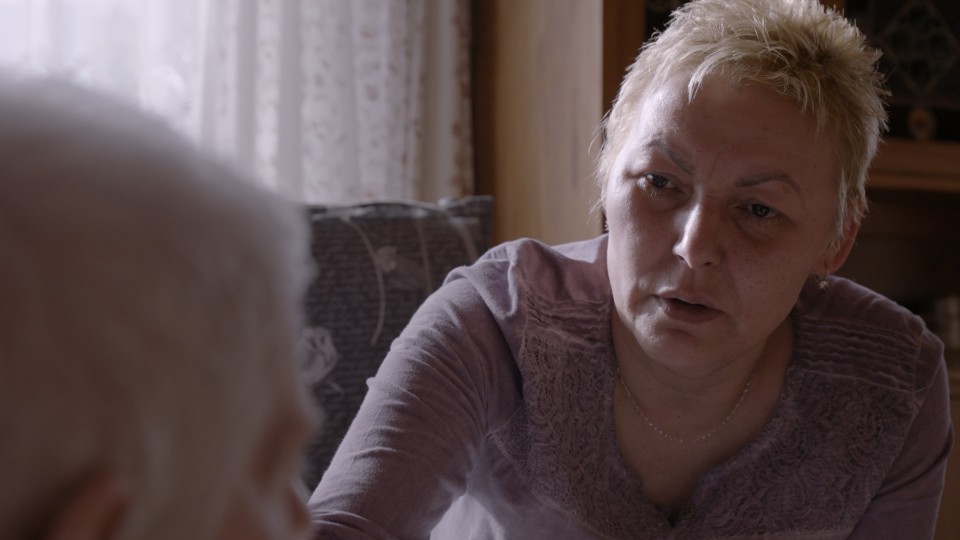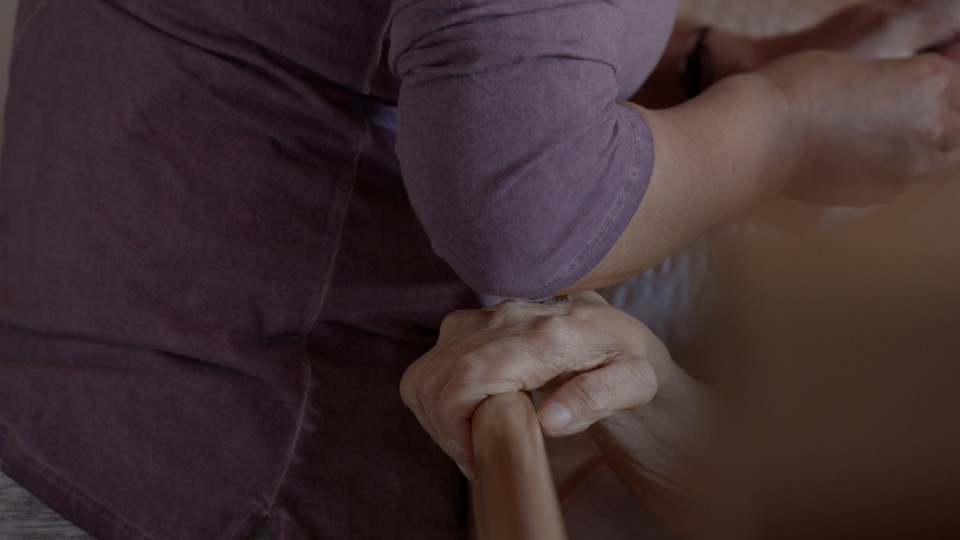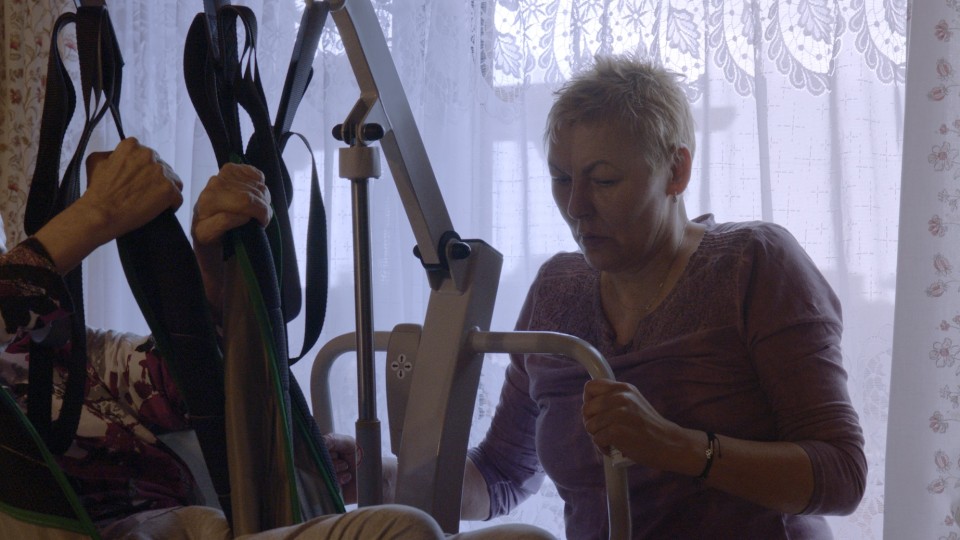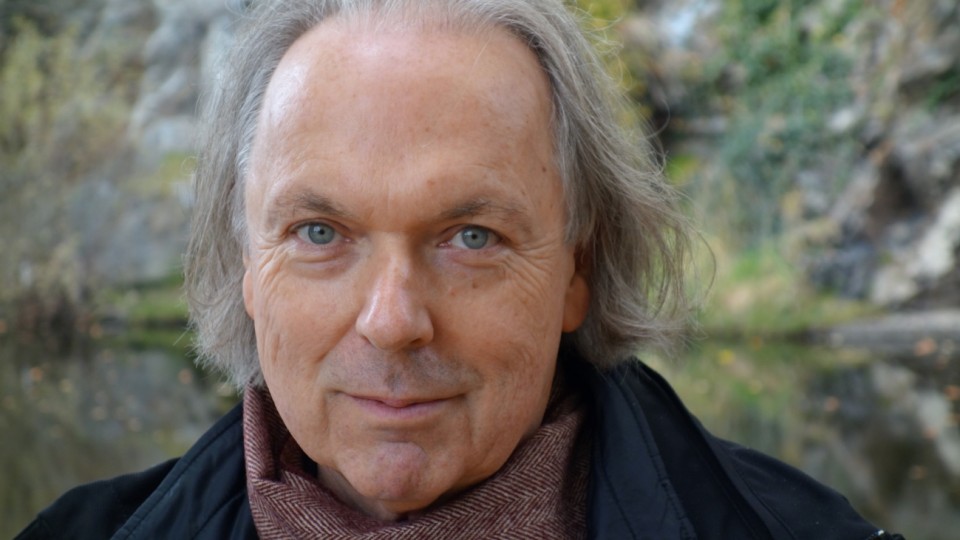They are all invisible. The old people no longer able to cope with everyday life without assistance – and also the women who
live under the same roof to provide them with the necessary care, which entails leaving their own homes for an extended period.
In 24 HOURS, Harald Friedl observes a Romanian nurse during the course of one care cycle, focusing attention on an activity that is performed
every day without receiving public perception or social recognition.
A glance at your filmography reveals the very varied themes featured in your cinema documentaries. Where do you get the impetus
to embark on a film project?
HARALD FRIEDL: In each case the subject is an opportunity to look at life, culture and society, and to render visible people who are usually
invisible. Thematically, I am strongly attracted to what interests me personally. In What Happiness Is it was the concept of Gross National Happiness in Bhutan; in Out of Time it was a fascination with these old Viennese shops and the people who run them. In Bread what captured my attention was how much this staple food has to say about ecology, social issues, the economy and health.
The initial trigger for 24 HOURS was the fact that Romanian nurses were flown to Austria during the first lockdown in 2020.
The borders were closed, but the money was found to fly in hundreds of women from poor backgrounds, pay them and put them
up for the quarantine period in empty hotels. Suddenly, these foreign women were given the recognition they don't normally
experience. I wrote a first film concept that is very close to the current film. However, it was clear that very different
films could be made, depending on who we were shooting with.
How did you familiarize yourself with the topic and the structures involved in Austria, and find your protagonist?
HARALD FRIEDL: I looked at the existing conditions of exploitation. There is a wide range of agencies. Many of them are above board, but
others exploit the situation wherever possible. So we posted our search for a protagonist on a platform where Romanian nurses
exchange comments. The director Jola Wieczorek, who was assistant director for 24 HOURS, did the preliminary research. Sadina
Lungu impressed us right from the start because she was uncomplicated, confident, eloquent and open. The woman she was caring
for, Elisabeth, and the legal guardians involved, also agreed. Elisabeth has no relatives anymore. So it was on the adult
representative to consent. The configuration was ideal. What I also liked about Sadina, apart from her friendly, dry manner,
was the dream she had: one time in her life, she wanted to fly a paraglider. We definitely wanted to make that wish come true
for her.
Why did you make the rather risky decision to focus on only one protagonist?
HARALD FRIEDL: I followed the advice of Constantin Wulff, who advised me on dramaturgical matters during the development phase. I was aware
of the risk, but I had a good feeling that working with Sadina would be intense. Initially, there was some uncertainty about
the 85-year-old woman Sabina was caring for; if we had felt she was rejecting us, we’d have had to pack our bags and start
searching again. But it turned out that Elisabeth had a lot of fun with us. She was glad there was finally something going
on in the house again. It was simply in line with her former way of life, when her husband was alive and she was still mobile.
How did you choose your introduction, where the film first shows Sadina's life in Romania and her journey to Austria?
HARALD FRIEDL: It was important to me to establish Sadina's family situation in Romania on film. I wanted the cinema audience to be aware
of the environment and circumstances that the protagonist comes from. During the film she uses video calls to maintain contact
with her family back in her hometown, Vulcan. These contacts help ensure she isn’t emotionally starved. Loneliness, combined
with hard work, constitutes a heavy burden. Sadina Lungu has no children, but she has three sisters, a brother and sick parents.
They are very present throughout the film by means of the video calls. These conversations with people back home open up deep
insights into Sadina’s soul. Work is always solely about Elizabeth's welfare; only these calls focus on Sadina’s feelings
as well.
Virtually the whole film is shot indoors. How did you establish the right distance, both narratively and ethically?
HARALD FRIEDL: Sadina's life is enacted largely in Elisabeth's house. The film was intended to reflect this reality. As far as playing with
closeness and distance is concerned, the challenge was to get close to the women without violating boundaries of intimacy.
A deep, trusting relationship quickly developed between Sadina and us. This meant we were able to work with complete freedom
and maximum consideration for the feelings of everyone concerned. Visually, we followed a strategy of allusion. There is no
nudity; all we see of the bathing process is the hose in the shower. In this way, the viewers can form their own inner images.
Strictly speaking, you have two protagonists – Sadina and Elisabeth.
HARALD FRIEDL: I didn't initially expect Elisabeth to become such a powerful presence in the film. When I first met her, she struck me as
more mentally absent than she was during filming. Having the crew in the house had an invigorating effect on her. As we filmed,
Elisabeth developed an increasingly strong life of her own and became a real antagonist to Sadina. We were pleased about the
way that developed. You can also see in the film how clearly Elisabeth manages to defend her position when something doesn't
suit her. I think this openness also gives the cinema audience the certainty that the filming took place under the correct
conditions.
How did you try to haul Elisabeth out of anonymity and tell us something about her life?
HARALD FRIEDL: The idea was that Elisabeth's life would only be depicted by means of the things that are visible in her apartment. The furniture,
the wall hangings, pictures, the photo with her husband, the photo of her as a little girl. The closet is often open; I felt
that shots of her clothes were very important. If there had been a picture on show in the apartment revealing that she was
a civil servant in the ministry, we would have shown it. The film is quite strict about these matters.
What beautiful, perhaps even surprising moments did you experience?
HARALD FRIEDL: The relationship between Sadina and Elisabeth had been developing for a long time, because Sadina was her caregiver when she
was still mobile and in much better shape. So Sadina knows a very different side to Elisabeth. She made it her mission to
be her companion, and she wouldn’t leave her. I came to understand that over time. The intensity of the care also entails
supplying closeness and familiarity. The film oscillates between tenderness and harshness, between consistency and loving
care, between laughter and crying, as Sadina says at one point. In this way, we managed to transform dry material into a film
that is lively and even cheerful for long stretches.
The journey at the beginning, from Romania to Austria, is tedious and full of traffic jams, while the drive back at the end
flies past in time lapse. How did you deal with the duration, with the time?
HARALD FRIEDL: The question of how best to handle the arrival preoccupied us a great deal in the editing process, and I think editor Philipp
Mayer resolved it wonderfully. The depiction of the care work had to push the audience's resilience to its limits, to convey
how hard it all is. That’s why we didn’t want the first grooming scene to be too short. In terms of motifs, the film ranges
from snow to the blossoms of spring, from freezing weather to time spent watering the garden. We sometimes had long days of
shooting. Once we set up the camera in front of Sadina's bed in the evening and sneaked into her bedroom very early the next
morning to film when she woke up. Of course, we’d agreed that beforehand.
What are the structures involved in connecting nurses and their clients?
HARALD FRIEDL: Sadina worked for an agency and had to pay a placement fee of €230 a month for years. She quit before we started filming
and is now employed by Elisabeth's legal guardian, who pays her out of Elisabeth's pension. On average, nurses are paid €
80 per day. They are not entitled to paid leave and receive sick pay only after 42 days of sick leave. And if they are worn
out towards the end of their lives, they get hardly any pension. Having their interests represented is difficult. Agencies
are companies, while nurses are self-employed. They both come under the Chamber of Commerce, which is not allowed to represent
one side against the other. And that means nurses don't have a lobby.
To some extent, did this portrait of a nurse also develop into a reflection on being old?
HARALD FRIEDL: Yes. There’s a lot of truth in the saying: everyone wants to grow old, but nobody wants to be old. At my age, the material fatigue is written all over your face. I can't suppress old age anymore, and I don't want to. Old
age makes me worried and uneasy: I can’t find much that’s positive about it, although I am aware that I have never felt better
or been clearer in my head that now. But if you look at Elisabeth: she is an old woman and dependent on outside help. Nobody
wants to be like that. At the same time, Elisabeth clearly shows that life has meaning as long as you enjoy it. Elisabeth
takes great pleasure in it. It’s worth being around for as long as you can do that. Will we ourselves ever be cared for as
well as Sadina cares for Elisabeth? That’s unlikely. The happiness of having a caregiver like Sadina is granted to only a
few. Sadina is a silent heroine of everyday life. But she won’t be awarded a medal or have a monument erected to her. At the
very least, this film is meant to be a tribute to her, a homage to Sadina Lungu. And as well as her, to tens of thousands
of women and a few men who, like her, work in 24-hour care.
Interview: Karin Schiefer
April 2024
Translation: Charles Osborne







